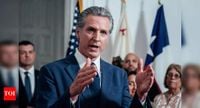In the heated landscape of American higher education, the battle lines have rarely been so sharply drawn. On one side, the Trump administration and its allies are pressing for sweeping changes to the nation’s universities—threatening funding, demanding ideological realignment, and targeting diversity, equity and inclusion (DEI) programs. On the other, prominent figures like California Governor Gavin Newsom and a handful of defiant institutions are pushing back, insisting that academic independence and democratic principles must not be sacrificed for political expediency or financial survival.
The most recent flashpoint erupted in August 2025, when Governor Newsom publicly rebuked some of the country’s most prestigious universities—Harvard, Columbia, Brown, and the University of Pennsylvania—for agreeing to multimillion-dollar settlements with the Trump administration. These settlements, according to reporting from multiple outlets, were struck to restore access to frozen federal research grants. The administration had accused the universities of either failing to curb campus antisemitism or promoting “woke” initiatives in violation of federal standards.
Newsom’s words were uncompromising. Speaking on Pod Save America, he declared, “UCLA is not going to sell their soul like Harvard or Brown or Penn or Columbia. Shame on all of them. We’re not. And we’re going to fight like hell to protect our democracy, our liberties, our freedoms.” He continued, “I love Republicans. I love Democrats. I don’t care what your party affiliation is. I honestly don’t. I care about this country and our democracy. I care about the rule of law.” According to Pod Save America, Newsom’s condemnation was not just rhetorical. He contrasted UCLA’s refusal to settle with the other universities’ decisions, positioning California as a bulwark against federal overreach.
The financial stakes are staggering. Harvard, for instance, is reportedly considering a settlement worth $500 million to regain access to over $2.6 billion in federal research funding, despite its endowment exceeding $50 billion. Newsom’s pointed question—“What’s the point of your damn endowment if you cannot stand on principle?”—echoes the frustration of critics who see these settlements as an abdication of moral authority. As Newsom put it, “We will never ever sell our soul to Donald Trump. Harvard, I pray you are listening. How could you? Of all institutions, on tens of billions of dollars, what’s the point of your damn endowment if you cannot stand on principle?”
Columbia University, meanwhile, agreed to a $200 million settlement and pledged to eliminate its DEI programs in exchange for the restoration of federal funding. The Trump administration’s demands have not stopped at financial penalties. According to In These Times, the administration has also sought to deport law-abiding international students—especially those who protest or write op-eds—effectively cutting universities off from lucrative international tuition revenue and silencing a potential source of activist opposition.
UCLA has become the emblem of resistance. The Trump administration is reportedly demanding a $1 billion settlement from the university, along with the creation of a $172 million claims fund for alleged Title VII violations under the Civil Rights Act. Newsom, speaking in San Francisco, thundered, “We’re not Brown, we’re not Columbia, and I’m not going to be governor if we act like that. Period. Full stop, I will fight like hell to make sure that doesn’t happen.” The standoff places UCLA at the center of a high-stakes confrontation, where the principles of academic freedom and financial necessity are in direct conflict.
These developments are not occurring in a vacuum. As In These Times details, the Trump administration’s hostility to higher education is part of a much longer tradition on the American right—a tradition marked by suspicion of intellectualism and critical thinking. In 2016, then-candidate Donald Trump famously proclaimed his love for “the poorly educated.” Since returning to office, Trump’s actions have made clear that this affection is rooted less in concern for the working class and more in the belief that an uneducated populace is easier to sway with “relentless lies and hypocrisies.”
Trump’s administration has gone further than previous conservative efforts, threatening to cut funding to universities perceived as hotbeds of intellectual opposition. His aides and advisors are working to build alternative models of higher education, modeled after institutions like Michigan’s Hillsdale College—a private Christian school known for its right-wing politics. The goal, critics argue, is not to nurture impartial scholarship but to create institutions that openly indoctrinate students with a particular ideological perspective.
The rationale behind these attacks often centers on fighting campus antisemitism or opposing DEI programs, which the right has cast as antithetical to meritocracy and discriminatory against white men. According to In These Times, this framing conveniently ignores the historical role of privilege in college admissions for the wealthy and well-connected.
The roots of this animosity toward universities run deep. Conservative thinkers from William F. Buckley Jr. in the 1950s to Roger Scruton in the 1980s have openly questioned the value of critical thinking and academic neutrality. Buckley, in his influential book God and Man at Yale, argued that education should instill the “correct values,” not encourage Socratic examination of all sides. This suspicion of intellectualism, as historian Don Herzog and others have shown, traces back to the earliest days of modern conservatism and even to the reactionary philosophies that underpinned European fascism. Figures like Edmund Burke and Joseph de Maistre warned that educating the masses would make them “less content with their lot” and more likely to demand political power.
Historical parallels abound. Under Mussolini and Hitler, universities were both suppressed and co-opted—faculty perceived as disloyal were banished, while loyalists and prominent academics were recruited to lend legitimacy to the regime. Today, according to In These Times, there are echoes of this approach as the Trumpist right seeks to remake higher education in its own image, emphasizing both ideological conformity and the sorting of society’s “winners and losers.”
The practical consequences of these ideological battles are stark. Federal agencies supplied more than 50 percent of all academic research and development funding nationwide last year, according to the National Science Foundation. When this funding is frozen or made contingent on political compliance, even elite institutions with massive endowments feel the strain. Faculty departures, stalled projects, and reputational damage are real threats. For many universities, settlements are seen as the price of survival—a pragmatic, if painful, decision to keep the lights on and the labs running.
Yet critics warn that such compromises legitimize political litmus tests for research funding, undermining the very independence that has long defined American higher education. Newsom’s defiance frames the moment as a moral test: “Stand firm for democracy or bend under financial duress.” Universities counter that without research dollars, their ability to innovate, cure diseases, and lead globally would collapse. But the charge of “selling their souls” lingers, not just as political theater but as a profound question about the future of academic freedom in America.
As the standoff continues, the fate of higher education hangs in the balance—caught between competing visions of its purpose and future, and between the demands of principle and the imperatives of survival.

